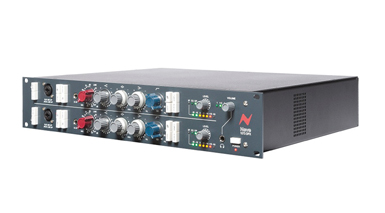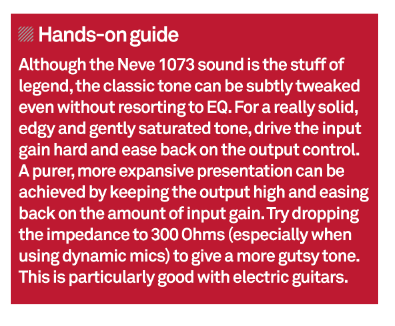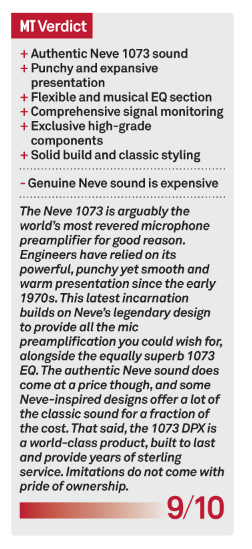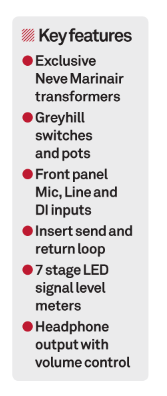Neve 1073 DPX Microphone Preamplifier and EQ Review
A brand new version of the 1073? John Pickford finds out if Neve has managed to gild the lily… Details Price £2,749 Contact AMS Neve Ltd. 01282 457011 Web www.ams-neve.com Amazon.co.uk Widgets For more than four decades, the Neve 1073 microphone preamplifier has been the first choice for pro-audio engineers the world over. It has […]

A brand new version of the 1073? John Pickford finds out if Neve has managed to gild the lily…


Details
Price £2,749
Contact AMS Neve Ltd. 01282 457011
Web www.ams-neve.com
For more than four decades, the Neve 1073 microphone preamplifier has been the first choice for pro-audio engineers the world over. It has been cloned many times and its sound has inspired countless other designs. Neve has produced several variations of the design over the years, including rack-mountable designs and 500-series Lunch Box units.
The original 1073 module was introduced in 1970, when it was featured in the A88 mixing console designed by Rupert Neve for Wessex Recording Studios. That console caught the ear of the top engineers of the day, resulting in the 1073 module being incorporated into the consoles of many professional independent studios. A legend was born.
This current 2U 19in rack-mountable model is a two-channel unit featuring Neve’s legendary three-band equaliser. It’s been produced to the exact specifications of the original design, although there are one or two useful additional features that help to meet 21st century demands.
The design team responsible for this latest incarnation includes John Turner and Robin Porter, both of whom have worked in Neve engineering for many years, stretching right back to the introduction of the very first 1073s. Every nuance of the 1073 performance runs through their blood, both in ultra-precise measurement and definitive listening, ensuring that this model produces the same results as the originals did when new. Vintage gear junkies may well lust after original units from the 1970s – however many of these will have drifted way out of specification by now.

What’s in the Box?
As a true Class A design, the 1073 DPX features two independent transformer-coupled microphone preamplifier and EQ circuits, employing Neve’s Marinair transformers on each input and output stage.
The full spec of these is exclusive to Neve, and their performance is a crucial element of the Neve 1073 sound. Other Neve-styled designs that make use of Carnhill transformers can produce a fair approximation, but only Neve can deliver the true sound. Greyhill switches and pots are used throughout and other top-grade internal components include metal film resistors and original through-hole components for coupling capacitors, EQ capacitors, signal transistors and EQ inductors.

Neve offers two variants of the 1073 DBX, one of which features a digital module accessed on the rear panel. Our review sample, however, is the standard analogue design. The front panel will be instantly familiar to anyone who has seen other versions of the 1073, with those classic white push buttons protruding from the grey fascia. Microphone and Line inputs are on both the rear and front of the unit; the push-button labelled Front has to be engaged to switch the audio to the combo connector on the front panel.
As per the original units, both Mic and Line input gain is controlled by a single rotary-switch, configured in the traditional Neve style. This switch feels lovely in use and oozes quality, delivering a satisfying click without producing any unwanted electrical pops or bumps. Up to 80dB of input-gain is available in 5dB steps, making it suitable for all types and models of microphone, including insensitive ribbon designs, while an output Level knob is provided along with an LED level meter.
Rather cleverly, the audio level can be monitored at three different parts of the signal path – pre-EQ, post-EQ and post output-stage – simply by pressing the Level knob. An LED illuminates to indicate which of the three ‘take-off points’ (as Neve describes them) is being monitored; these LEDs glow red when the unit is close to clipping.

Bits and Bobs
Headphone monitoring is catered for via a stereo output jack and volume knob. This knob too can be pressed to cycle through three options of monitoring: Channel 1 only, Channel 1 (left ear) and Channel 2 (right ear) and Channel 2 only; an LED indicates which option has been selected.
As you might expect on a fully-featured mic-pre such as this, switches are provided to engage 48V phantom power and invert polarity (phase), while other switches include Lo-Z to drop the microphone input impedance to 300 Ohms from the standard 1200 Ohms, and both a 20dB pad and ground-lift for the DI input on the front panel. There’s an insert loop on the rear panel for the connection of another unit – a compressor for example – and this can be configured to appear before or after the equalisation circuit.
The 1073 EQ section is almost as legendary as the preamp itself, offering three bands of smooth equalization. The High-band provides +/- 16dB of shelving EQ fixed at 12kHz, while the Mid-band is a +/- 18dB peaking EQ with selectable frequencies centred on 360Hz, 700Hz, 1.6kHz, 3.2kHz, 4.8kHz and 7.2kHz. The
Low-band is another +/- 16dB shelving EQ selectable at 35Hz, 60Hz, 110Hz and 220Hz. Both the Mid and Low bands are controlled by dual-action pots to select frequency and level of boost or cut. In addition to this, a High-Pass-Filter provides an 18dB per octave slope at frequencies of 50Hz, 80Hz, 160Hz or 300Hz.
The sound of an on-spec Neve 1073 (DPX or otherwise) is one of those ‘once heard never forgotten’ experiences. We’ve encountered all manner of 1073-style units over the years – many of them rather good – however, only genuine Neve products deliver the magical sound that has beguiled engineers for over four decades. In a nutshell, the sound is big, punchy, smooth and warm. But that’s only half the story – it’s also solid, focused and stable with an expansive, open nature.

Those who prefer a more transparent approach to microphone preamplification might describe the sound as larger-than-life and coloured, however, there are other units, such as the LEV Solutions Integrity II (reviewed in this issue), which offer a more accurate, if less characterful presentation. And what a character the 1073 DPX has! Unlike some solid-state designs there is no graininess to the sound, rather it has a rich and deep character akin to a good valve design. Indeed, when compared to our reference Early Bird valve mic-pre, the 1073 sounded warmer with a fuller low-midrange, giving the lie to that old chestnut that all valve designs sound warm while solid-state is bright and brittle.
The 1073 DPX is certainly not brittle-sounding and there is no upper-mid glare that often hampers less capable designs. A side-by-side comparison with the preamps in our DDA desk confirmed the full-bodied nature of the 1073, leading one listener to remark that the 1073 sounded ‘tubby’, when in fact the DDA has a more scooped low-mid response and accentuated treble presence.
We used the Neve extensively during the review period, using a wide variety of microphones, with generally excellent results. A pair of Coles 4038 ribbons used as drum overheads sounded so good with the 1073’s 12kHz boost, we were loath to bring-up any of the spot-mics.
Electric guitars and basses sounded suitably gutsy through the preamp, while a lead vocal from a rock singer was enhanced with a subtle 3.2kHz boost at the tracking stage to add presence. Using an AKG C414 to record an acoustic rhythm guitar overdub, we found the Neve to be a little too rich and full-bodied for the track, and while we were able to sculpt the tone with EQ, we ultimately opted for our valve unit to provide a touch of sweetness that the 1073 lacks.
In the world of mic-preamps the Neve 1073 DPX is a big player with a warm heart. It has bags of character that’s almost always flattering to the audio that passes through it, especially in the world of heavily processed modern music. Part of its appeal is in its familiarity; the classic 1073 sound can be heard on thousands of recordings from the early 1970s to the present day. Anyone who wants the real deal, big and punchy 1073 sound should stop dreaming of owning an over-priced and possibly out-of-spec original unit and get one of these.
It’s built like a tank with first-class, exclusive components and will provide years of trouble-free service. Other boutique designs that major on transparency might like to think of themselves as the Rolls Royce of microphone preamplifiers, but this one is the Aston Martin – the one that we all really want to own.




